

Ribosome. Figure 1 : The ribosome assembles polymericproteinmolecules whose sequence is controlled by the sequence of messenger RNA molecules.
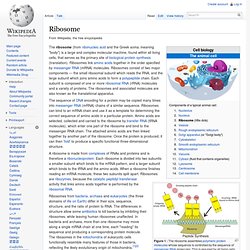
This is required by all living cells and associated viruses. The sequence of DNA encoding for a protein may be copied many times into messenger RNA (mRNA) chains of a similar sequence. Ribosomes can bind to an mRNA chain and use it as a template for determining the correct sequence of amino acids in a particular protein. Amino acids are selected, collected and carried to the ribosome by transfer RNA (tRNA molecules), which enter one part of the ribosome and bind to the messenger RNA chain. The attached amino acids are then linked together by another part of the ribosome. Nenad Ban's scientific work is regarded as a milestone in biochemical research.
Professor Nenad Ban, distinguished Croatian scientist ETH Professor Nenad Ban, Timm Maier, Marc Leibundgut and Simon Jenni (left to right) were so successful with their work on the structural analyses of fatty acid synthases in mammals and fungi that they had two publications in the same issue of "Science".See The architecture of fatty acid factories.
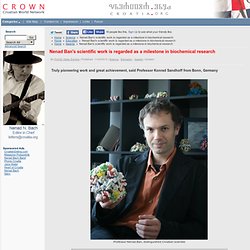
Professor Nenad Ban and his research group - The Ban Lab, ETH, Zurich, Switzerland 2010. Older photos. Thomas A. Steitz with colleagues during the reception at the Royal Swedish Academy of Sciences in Stockholm, 7 December 2009. Formated for CROWN by prof.dr. Detailed view of a crucial enzymatic complex revealed. Researchers led by ETH professor Nenad Ban have now completed the three-dimensional structure of the ribosome from a higher organism.
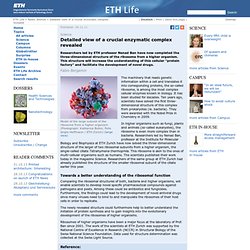
This structure will increase the understanding of this cellular “protein factory” and facilitate the development of novel drugs. The machinery that reads genetic information within a cell and translates it into corresponding proteins, the so-called ribosome, is among the most complex cellular enzymes known in biology. It has been studied for decades. Ten years ago, scientists have solved the first three-dimensional structure of this complex from prokaryotes (ie. bacteria). They were awarded with the Nobel Prize in Chemistry in 2009. University of Zagreb. The University of Zagreb (Croatian: Sveučilište u Zagrebu, Latin: Universitas Studiorum Zagrabiensis) is the largest Croatian university and the oldest continuously operating university in the area covering Central Europe south of Vienna and all of Southeastern Europe.[3] As of 2011, University of Zagreb is ranked among the 500 Best Universities of the world by the Shanghai Academic Ranking of World Universities.[4] History[edit] Academy[edit] Zagreb University, Faculty of Law.
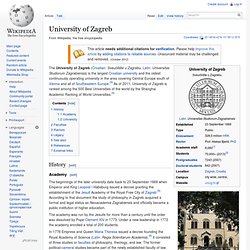
Shape memory materials ready for mass production. Five years ago, Professor Mirko Gojic, a researcher at the University of Zagreb in Croatia, wondered what his small team of researchers could do to lower the price of ‘smart metals’: a type of high-tech materials that can remember their original cold-forged shape, returning the pre-deformed shape by heating – a property that makes them crucial in a series of industries.

The idea was there, but problems quickly aroused from lack of money and key equipment. Thanks to the support of EUREKA, the product is now almost finalised and could be rolled out within the next two years. Gojic thinks that this international research project he led could soon turn into commercial production of a cheaper alloy for use in aerospace engineering or electronics. Shape memory alloys can be produced to many shapes and sizes for various uses. Although not as strong as steel, they are much more elastic and their properties allow them to adopt the needed shape when exposed to high temperatures. A Team effort Dr. Croatian Researchers Develop Cheaper Shape Memory Alloys. By Cameron Chai The project has been led by a researcher at Zagreb University, Professor Mirko Gojic and it has received tremendous support from EUREKA.

Shape memory materials for use in smartphones and high-tech gadgets The titanium and nickel based alloy utilized to make shape memory materials is expensive and hence researchers have begun searching for cheaper alternatives. Shape memory alloys can be manufactured in several sizes and shapes for a wide range of applications. These alloys are used in medical applications, robotics and smart phones. Ruđer Bošković Institute. The Ruđer Bošković Institute (RBI; Croatian: Institut Ruđer Bošković, pronounced [instǐtuːt rûd͡ʑɛr bɔ̂ʃkɔʋit͡ɕ], IRB) is a research institute located in the Šalata neighborhood of Zagreb, Croatia, founded in 1950, which studies the sciences.

It is the largest Croatian research institute in the fields of the natural sciences and technology. The name of the institute, which honours the scientist Ruđer Bošković, was put forth by one of its founders, physicist Ivan Supek. Within Croatia, RBI is a national institution dedicated to research, higher education and provision of support to the academic community, to state and local governments and to technology-based industry. Within the European Union, RBI forms a part of the European Research Area. Worldwide, RBI collaborates with many research institutions and universities upholding the same values and vision. Divisions[edit] Bacteria shed light on new drug targets for inherited cancers - myScience / news from the lab/ news 2011. Progeria. Progeria (pronunciation: /proʊˈdʒɪəriə/[1][2]) (Hutchinson–Gilford progeria syndrome,[3][4] HGPS, progeria syndrome[4]) is an extremely rare genetic disorder wherein symptoms resembling aspects of aging are manifested at a very early age.
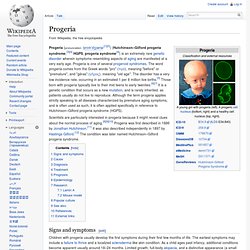
Progeria is one of several progeroid syndromes. The word progeria comes from the Greek words "pro" (πρό), meaning "before" or "premature", and "gēras" (γῆρας), meaning "old age". The disorder has a very low incidence rate, occurring in an estimated 1 per 8 million live births.[5] Those born with progeria typically live to their mid teens to early twenties.[6][7] It is a genetic condition that occurs as a new mutation, and is rarely inherited, as patients usually do not live to reproduce. Although the term progeria applies strictly speaking to all diseases characterized by premature aging symptoms, and is often used as such, it is often applied specifically in reference to Hutchinson–Gilford progeria syndrome (HGPS).
Signs and symptoms[edit] Cause[edit] Progeria Patients May Find Hope in New Drug. <br/><a href=" US News</a> | <a href=" Business News</a> Copy When Zoey Penny was only 4 weeks old, her parents noticed that the skin on her belly was hard to the touch.

What they thought was a rash began to spread to her thighs and back. Months passed without an answer, as doctors and specialists ran batteries of tests on her little body. In March 2010, she was finally diagnosed with Hutchinson–Gilford Progeria Syndrome, an extremely rare and fatal genetic disorder which causes children to age eight to 10 times the normal rate. The word progeria comes from the Greek word meaning "prematurely old. " "Zoey is 20 months old and only weighs 14 pounds," said her grandfather, John Marozzi, of Boonton Township, N.J. Croatian scientist gives new hope to rapidly ageing children. Wednesday, 16.
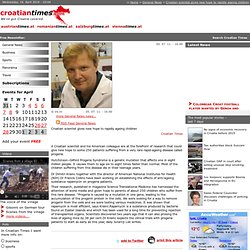
April 2014 - 10:04 :: Home > General News > Croatian scientist gives new hope to rapidly ageing children Events for April Add your event FREE Videos.